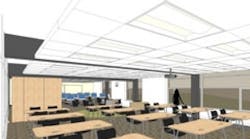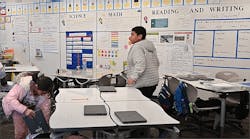Classroom design for the 21st-century learning environment should accommodate a variety of learning skills and needs. The space should be large enough so it can be configured to accommodate a number of learning activities. This also includes furniture that provides flexibility and accommodates collaboration and interactive work among students and teachers.
Flexibility is a recurring theme throughout the history of school design. In the framework of a 21st-century learner, flexibility in the learning environment is even more critical. Many space configurations are possible for learners. Some of the new configurations will have to provide for teacher-directed instruction, individual study, small groups, large groups, presentations, one-on-one instruction, as well as discussions among students and teachers. Classrooms with flexible space and furniture should enable learning to take place through all of these media.
Mobile learning
By using mobile tables and chairs, a learner can create the proper setting for the activity being performed. Mobile tables of 30 by 60 inches or 36 by 72 inches can accommodate a small or larger group discussion as well as a presentation format.
Project-based learning is a key attribute of a Science, Technology, Engineering, and Mathematics (STEM) curriculum. Mobile tables enable different configurations in different areas of a space and accommodate learning flexibility.
Technology also must be accommodated in a variety of ways. Furnishings must allow for one or 21 computers, as well as a variety of visual media. Classrooms and furniture need to adapt to a student’s learning style.
The furniture itself must be flexible to meet the needs of users who have different sizes and proportions. Ergonomics will play an important role in the 21st-century learning environment. Flexibility for furniture location as well as furniture adjustments is essential. Because a student will sit for long periods during a school day, the furniture should adjust to a number of different positions, heights, angles and movements.
The student’s physical body also will dictate furniture flexibility. Physical attributes in our youth are becoming more diverse.
It is important not to equate flexibility with more openness. Many schools experimented with open-concept classrooms in the 1970s and 1980s. Flexibility was taken to the extreme at the expense of other characteristics in a learning environment—acoustics, visual distraction, daylighting, size and proportions of space. Taking all these factors into account will determine the success of today’s students.
Larger classrooms, movable walls and mobile storage units can provide flexible classroom configurations. Structural systems available today in schools enable architects to change classroom walls more easily, and at less cost to the institution. Movable storage systems provide mass for acoustical separation as well as visual separation of classroom spaces.
Classroom sizes of 1,000 to 1,200 square feet provide for zones within the room for different activities.
How we learn will change in the future, just as it has changed in the past. Learning styles, subjects, technology and students evolve. School spaces and what we put in them must adapt readily to this change. Compromising future students’ learning opportunities is not an option. Schools must provide the best so their goals can be achieved.
- Watch a related video about Resourceful Interior Design.
Hassell is a partner at Plunkett Raysich Architects, Milwaukee, Wis., a firm that specializes in the planning, design and interior design of education facilities. He can be reached at [email protected].



